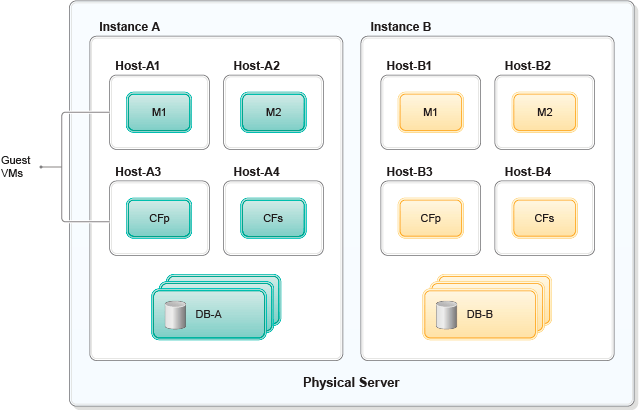You might find that creating a DB2® pureScale® instance
on a single physical server is useful in some environments.
Before you begin
Creating a DB2 pureScale instance
in a virtual environment using a single physical server is not supported
in a production environment. It is only for demonstration, education,
and internal testing.
You must have a network adapter for the
service console or VMkernal, and a separate network adapter for the
public network to be able to connect to remote clients. You must
have a local disk or FC SAN storage that you export as virtual disks
to the guest VMs.
About this task
In a single physical host environment, the
DB2 pureScale instance
remains available if there is a software or operating system failure
on a virtual machine (VM). If the physical server that is hosting
the
DB2 pureScale instance
is unavailable, you cannot access that
DB2 pureScale instance.
Figure 1 shows the network topology of a
DB2 pureScale instance
on a single physical server.
Figure 1. Network topology of a DB2 pureScale instance
on a single physical server
Procedure
To create a DB2 pureScale instance
in a Linux virtual environment
with one physical server:
- Install and configure VMware ESX/ESXi 5.0
- Configure a host-only IP address to be used as the private
network for all VMs on this host.
- Configure a shared host IP address to be used as the public
network for all VMs sharing host IP address. You must configure a
shared host IP address to access the external network.
- Create a guest VM image for the first DB2 pureScale member
on the physical server.
- Assign your exported virtual disks to the member VM. Refer
to pureScale disk requirements
for how many shared disks that are required
- Install Linux operating
system on the guest VM.
- You can create more DB2 pureScale members,
the primary cluster caching facility (CF), and the secondary CF by
cloning the VM image of the first member or following the same procedure.
All guest VMs that you create must reside on the same physical server.
- Install the DB2 pureScale Feature.
When you create the pureScale instance,
choose the guest VMs that you created on the same physical server.
- Create a database or move existing databases to the instance
you created.
What to do next
You can repeat this procedure to define other instances on
the same set of physical machines. Each instance can host one or more
databases. You must configure the client application machine to connect
to the server that hosts the DB2 member
before you are able to use it.
